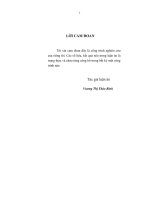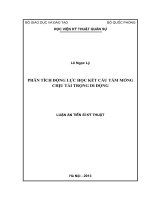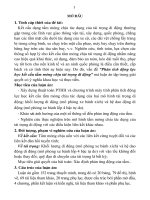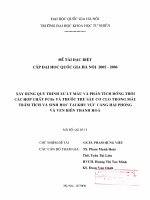phân tích đồng thời các dạng dimethyldiselenite, selenomethioline, selenit and selenat trong mẫu thủy hải sản tt
Bạn đang xem bản rút gọn của tài liệu. Xem và tải ngay bản đầy đủ của tài liệu tại đây (592.26 KB, 12 trang )
Phân tích đồng thời các dạng
Dimethyldiselenite, Selenomethioline, Selenit
and Selenat trong mẫu thủy hải sản
Hoàng Thị Dung
Trường Đại học Khoa học Tự nhiên
Luận văn Thạc sĩ ngành: Hóa học; Mã số: 60 44 01 18
Người hướng dẫn: PGS.TS. Tạ Thị Thảo
Năm bảo vệ: 2013
Abstract. Chuẩn hóa lại các điều xác định tổng hàm lượng selen bằng phương pháp
HVG-AAS. Chuẩn hóa lại mô hình hồi qui đa biến theo phương pháp PCR. Nghiên cứu
sự chuyển dạng và mất chất phân tích khi bảo quản mẫu. Nghiên cứu ảnh hƣởng của
chất đi kèm trong nền mẫu thực phẩm và tách loại chúng. Đánh giá qua phân tích mẫu
giả tự tạo, từ đó phân tích mẫu thực tế.
Keywords. Hóa phân tích; Thủy sản; Hải sản; Hàm lượng Selen; Phương pháp hóa học
Content:
MỤC LỤC
MỤC LỤC
DANH MỤC BẢNG BIỂU
DANH MỤC HÌNH VẼ
DANH MỤC TỪ VIẾT TẮT
MỞ ĐẦU 1
CHƢƠNG 1. TỔNG QUAN 2
1.1. Trạng thái tự nhiên và tính chất phân tích của selen 2
1.1.1. Các dạng tồn tại của selen và sự chuyển hóa của Selen trong môi trƣờng
và thực phẩm 2
1.1.2. Tác động của selen đối với sức khỏe con ngƣời 5
1.2. Xác định tổng hàm lƣợng selen bằng phƣơng pháp phổ nguyên tử 6
1.3. Các phƣơng pháp phân tích dạng 11
1.3.1. Phƣơng pháp phân tích trắc quang 11
1.3.2. Nhóm phƣơng pháp phân tích điện hóa. 12
1.3.3. Các phƣơng pháp ghép nối 13
1.3.4. Phƣơng pháp phân tích kết hợp với sử dụng chemometric 15
1.4. Phƣơng pháp xử lý mẫu phân tích có chứa selen 23
1.4.1. Xử lý mẫu phân tích dạng 23
1.4.2. Bảo quản mẫu để phân tích dạng selen 26
CHƢƠNG 2. THỰC NGHIỆM 27
2.1. Nội dung và phƣơng pháp nghiên cứu 27
2.1.1. Mục tiêu nghiên cứu 27
2.1.2. Nguyên tắc phƣơng pháp xác định dạng Selen bằng HVG-AAS 27
2.1.3. Nội dung nghiên cứu 28
2.2. Hóa chất, thiết bị và dụng cụ thí nghiệm 28
2.2.1. Thiết bị và dụng cụ thí nghiệm 28
2.2.2. Hoá chất 29
2.2.3. Các phần mềm tính toán và xử lí số liệu phân tích 30
2.3. Tiến hành thí nghiệm 30
2.3.1. Quy trình phân tích 30
2.3.2. Thuật toán và câu lệnh tính toán phƣơng trình hồi quy đa biến 32
CHƢƠNG III. KẾT QUẢ VÀ THẢO LUẬN 36
3.1. Chuẩn hóa lại các điều kiện xác định tổng hàm lƣợng selen bằng phƣơng
pháp HVG-AAS 36
3.1.1. Điều kiện đo phổ AAS xác định Se(IV) 36
3.1.2. Nghiên cứu ảnh hƣởng của các chất khử đối với quá trình khử các dạng
selen thành selennua 37
3.1.3. Hiệu suất khử các dạng selen phụ thuộc vào môi trƣờng 38
3.2. Chuẩn hóa lại mô hình hồi quy đa biến 38
3.2.1. Xây dựng đƣờng chuẩn đa biến 38
3.2.2. Đánh giá tính phù hợp của phƣơng trình hồi qui thông qua mẫu tự tạo 40
3.2.3. Xác định nồng độ các dạng selen trong mẫu tự tạo theo mô hình PCR. 40
3.3. Nghiên cứu sự chuyển dạng và mất chất phân tích khi bảo quản mẫu 41
3.3.1. Ảnh hƣởng của pH và vật liệu bình chứa 41
3.3.2. Ảnh hƣởng của oxi 44
3.3.3. Ảnh hƣởng của ion Fe
3+
và cách loại trừ 47
3.4. Nghiên cứu ảnh hƣởng các yếu tố đi kèm trong nền mẫu thực phẩm 50
3.4.1. Ảnh hƣởng của chất béo stearin và cách loại trừ. 50
3.4.2. Ảnh hƣởng của protein abumin đến tín hiệu đo 52
3.4.3. Loại trừ ảnh hƣởng chất béo bằng cột SPE 54
3.5. Phân tích mẫu thực tế 59
3.5.1. Khảo sát tỉ lệ dung môi chiết 59
3.5.2. Khảo sát ảnh hƣởng thời gian rung siêu âm 60
3.5.3. Ảnh hƣởng của số lần chiết lặp 61
3.5.4. Hiệu suất thu hồi 61
3.5.5. Lấy mẫu thủy-hải sản và xử lí sơ bộ mẫu 62
3.5.6. Phân tích mẫu thực 63
KẾT LUẬN 66
TÀI LIỆU THAM KHẢO 68
68
TÀI LIỆU THAM KHẢO
Tiếng Việt
1. Bách khoa toàn thƣ (2008), http://vi. Wikipedia.org/wiki/Selen.
2. Đàm Trung Bảo, Đặng Hồng Thuý (1983), Selen trong sinh học, NXB Y học,
Hà Nội, Tr. 5 - 95, 115 - 117.
3. Quyết định của bộ tài nguyên môi trƣờng số 16/2008/QĐ-BTNMT
4. Nguyễn Văn Cƣơng (2011), Nghiên cứu các điều kiện xác định đồng thời các
dạng Se bằng phương pháp HVG – AAS sử dụng chemometrics, Luận văn
thạc sỹ khoa học, Đại học Khoa học Tự nhiên- ĐH QGHN.
5. Lê Thị Duyên (2012), Nghiên cứu xác định một số dạng selen trong hải sản
bằng phương pháp Von-Ampe hòa tan, Luận án tiến sỹ khoa học, Viện hóa
học Việt Nam.
6. Nguyễn Thị Thúy Hằng (2011), Phân tích dạng Se(IV), Se(VI) vô cơ trong mẫu
nước ngầm và thực phẩm bằng phương pháp động học – xúc tác trắc quang,
Luận văn thạc sỹ khoa học, Đại học Khoa học Tự nhiên- ĐH QGHN.
7. Nguyễn Hoàng Hải, Nguyễn Việt Anh (2005), Lập trình Matlab và ứng dụng,
NXB KHKT, Hà Nội.
8. Dr Phạm Luận (1999), Giáo trình hướng dẫn về những vấn đề cơ sở của các kỹ
thuật xử lý mẫu phân tích, NXB Hà Nội.
9. Hoàng Nhâm (2001), Hoá học vô cơ, tập 2, NXB Giáo Dục.
10. Nguyễn Phùng Quang (2006), Matlab và Simulink, NXB KHKT, Hà Nội.
11. Lâm Ngọc Thụ, Lê Văn Tán, Ngô Văn Tứ (1997), Xác định selen trong cây
trinh nữ (Mimosa Pudical) bằng thuốc thử triôxyazobenzen, Tạp chí phân
tích Hóa, Lý và Sinh học, Tập 2(1+2), 28-29, 36.
12. Nguyễn Ngọc Tuấn (1996), Đánh giá hàm lượng các nguyên tố Iod, Thuỷ ngân
và Arsen trong một số đối tượng môi trường bằng phương pháp kích hoạt
nơtron, Luận án PTS khoa hóa học, Đại học Khoa học Tự nhiên- ĐH QGHN.
Tiếng Anh:
69
13. Mohammed Joinal Abedin, Jo¨rgFeldmann, and Andy A. Meharg (2002),
“Uptake Kinetics of Arsenic Species in Rice Plants”, Plant Physiology,128,
pp. 1120–1128.
14. Mike J. Adams (2004), “Chemometrics in Analytical Spectroscopy”, Royal
Society of Chemistry, UK.
15. M. Navarro-Alarcon, C. Cabrera-Vique (2008), “Selenium in food and the
human body”, Science of The Total Environment, 400(1-3), pp. 115-141. 47
16. Analyst (1995), 120, pp. 1433-1436.
17. Anirban Ray, S. Dutta Gupta, Sampad Ghosh, Shashaank M. Aswatha,
BibekKabi (2013), “Chemometric studies on mineral distribution and
microstructure analysis of freeze-dried Aloe vera L. gel at different
harvesting regimens”, Industrial Crops and Products,51, pp. 194–201.
18. J.L. Gosmez-Ariza, J.A. Pozas, I. Giráldez, E. Morales (1998), “Speciation of
volatile forms of selenium and inorganic selenium in sediments by gas
chromatography-mass spectrometry”, Journal of chromatography A, 823(1-
2), pp. 259-277.
19. Arunachalam, J.,Carboo, D.,Cornelis (2004), “Speciation Analysis of Arsenic
Chromium and Selenium in Aquatic Media”, Proceedings of a final research
coordination meetingheld in Vienna, pp. 26–29.
20. G.E. Batley (1986), “Differential-pulse polarographic determination of
selenium species in contaminated waters”, Analytica Chimica Acta,187, pp.
109-116.
21. D. Bohrer, E. Becker, P. Cícero do Nascimento, M. Dessuy, L. Machado de
Carvalho (2007), “Comparison of graphite furnace and hydride generation
atomic absorption spectrometry for the determination of selenium status in
chicken meat”, Food Chemistry, 104(2), pp. 868-875.
22. M. Bueno, M. Potin-Gautier (2002), “Solid-phase extraction for the
simultaneouspreconcentration of organic (selencystin) and inorganic [Se(IV),
70
Se(VI)] selenium innatural waters”, Journal of Chromatography A, 963(1-2),
pp. 185-193.
23. C. Cámara, R. Cornelis, P. Quevauviller (2000), “Assessment of methods
currently used for the determination of Cr and Se species in solution”, AC
Trends in Analytical Chemistry, 19(2-3), pp. 189-194.
24. A. Chatterjee, Y. Shibata, M.Morita (2001), “Determination of selenmethionin
by high performance liquid chromatography-direct hydride generation-
atomic absorption spectrometry”, Microchemical Journal, 69(3), pp. 179-
187.
25. A. Chatterjee, H. Tao, Y. Shibata, M. Morita (2003), “Determination of
selenium compounds in urine by high-performance liquid chromatography–
inductively coupled plasmamass spectrometry”, Journal of Chromatography
A, 997(1-2), pp. 249-257.
26. Beibei Chen, Bin Hu, Man He, Qian Huang, Yuan Zhang, Xing Zhang (2013),
“Speciation of selenium in cells by HPLC-ICP-MS after (on-chip) magnetic
solid phase extraction”, Show Affiliations, 28, pp. 334-343.
27. Chimica acta (1993), 274, pp. 219-224.
28. Michał Daszykowski, Sven Serneels, Krzysztof Kaczmarek, Piet Van Espen,
Christophe Croux, Beata Walczak (2007), “A MATLAB toolbox for
multivariate calibration techniques”, Chemometrics and Intelligent
Laboratory Systems, 85(2), pp. 269-277.
29. Duan J, Hu B, He M. (2012), “Nanometer-sized alumina packed microcolumn
solid-phase extraction combined with field-amplified sample stacking-
capillary electrophoresis for the speciation analysis of inorganic selenium in
environmental water samples”, Electrophoresis, 33(19-20), pp. 2953-2960.
30. Jorge Ruiz Encinar, Magdalena Śliwka-Kaszyńska, Aleksandra Połatajko,
VéroniqueVacchina, Joanna Szpuna, (2003), “Methodological advances for
selenium speciation analysis in yeas”, Analytica Chimica Acta, 500(1–2),
pp.171.
71
31. Tommaso Ferri, Silvia Rossi, Paola Sangiorgio, “Simultaneous determination
of the speciation of selenium and tellurium in geological matrices by use of
an iron(III)-modified chelating resin and cathodic stripping voltammetry”,
Analytica Chimica Acta, 336(1-2), pp. 113–123.
32. S. Forbes, G.P. Bound, T.S. West (1979), “Determination of selenium in soils
and plants by differential pulse cathodic-stripping voltammetry”,Talanta
,6(6), pp. 473-477.
33. Károly Héberger (2004), “Chemometrics in Hungary (the last 10 years)”,
Chemometrics and Intelligent Laboratory Systems, 72(2), pp. 115-122.42
34. Hegedus O, Hegedusová A, Simková S, Pavlík V, Jomová K, (2008),
“Valuation of the ET-AAS and HG-AAS methods of selenium determination
in vegetables”, Journal of Biochemical and Biophysical Methods,70, pp.
1287–1291.
35. J. T. Gene Hwang, Dan Nettleton (2002), “Principal Components Regression
with Data-Chosen Components and Related Methods”.
36. Ihnat M, Miller HJ (1977), “Analysis of foods for arsenic and selenium by acid
digestion, hydride evolution atomic absorption spectrophotometry”, J Assoc
Off Anal Chem, 60(4), pp. 813-825.
37. R. Inam and G. Somer (2000), A direct method for the determination of
selenium and lead in the Cow’s Milkby differential pulse stripping.
38. Ipolyi, W. Corns, P. Stockwel l, P. Fodor (2001), “Speciation of inorganic
selenium and selenoamino acids by an HPLC-UV-HG-AFS system”, Journal
of Automated Methods & Management in Chemistry, 23(6), pp. 167-172.
39. I. Ipolyi, P. Fodor (2000), “Development of analytical systems for the
simultaneous determination of the speciation of arsenic [As(III),
methylarsonicacid, dimethylarsinic acid, As(V)] and selenium [Se(IV),
Se(VI)]”, Analytic Chimica Acta, 413, pp. 13-23.
40. I. Ipolyi, Zs. Stefánka, P. Fodor (2001), “Speciation of Se(IV) and the
selenoamino acids by high-performance liquid chromatography-direct
72
hydridegeneration-atomic fluorescence spectrometry”, Analytica Chimica
Acta, 435, pp. 367-375.
41. G. Kölbl (1995), “Concepts for the identification and determination of
selenium compounds in the aquatic environment”, Marine Chemistry, 48(3-
4), pp. 185-197.
42. Richard Kramer (1998), Chemometric techniques for quantitative analysis,
Marcel Dekker, Inc, New York, USA.
43. Lange, C.M.G. van den Berg (2000), “Determination of selenium by catalytic
cathodic stripping voltammetry”, Analytica Chimica Acta, 418, pp. 33-42.
44. X.C. Le, X.F. Li, V. Lai, M. Ma, S. Yalcin, J. Feldmann (1998),
“Simultaneous speciation of selenium and arsenic using elevated temperature
liquid chromatography separation with inductively coupled plasma mass
spectrometry detection”, Atomic Spectroscopy, 53(6-8), pp. 899-909.
45. F. Li, W. Goessler, K.J. Irgolic (1999), “Determination of
trimethylselenoniumiodide, selenmethionin, selenious acid, and selenic acid
using highperformance liquid chromatography with on-line detection by
inductively coupled plasma mass spectrometry or flame atomic absorption
spectrometry”, Journal of Chromatography A, 830(2), pp. 337-344.
46. Tser-Sheng Lin. (2007), “Inorganic selenium speciation in groundwaters by
solid phase extraction on Dowex 1X2”, J Hazard Mater, 149(1), pp. 80-85.
47. R. Loinski, J. S. Edmonds, K.T. Suzuki, and P.C. Uden
(2000),“Speciesselective determination of seleniumcompounds in biological
materials”, Pure Appl. Chem, 72(3), pp. 447-461.
48. Magda A. Akl, Dalia S. Ismael, Ahmed A. El-Asmy (2006), “Precipitate
flotation-separation, speciation and hydride generation atomic absorption
spectrometric determination of selenium(IV) in food stuffs”, Microchemical
Journal, 83(2), pp. 61–69.
73
49. N. Maleki, A. Safavi, M. Mahdi Doroodmand (2005), “Determination of
selenium in water and soil by hydride generation atomic absorption
spectrometry using solid reagents”, Talanta, 66(4), pp. 858-862.
50. Badal Kumar Mandal, Das D, Chatterjee A (1975), “Arsenic in ground water in
six districs of best Bengal, Iidia – The biggest arsenic alamity in the world”,
Analytical Chemistry, 120(3), pp. 17-24.
51. Howard Mark and Jr.Jerry (2007), Workman, Chemometrics in Spectroscopy.
52. S. McSheehy, W. Yang, F. Pannier, J. Szpunar, R. Łobi´nski, J. Auger,
M.Potin-Gautier (2000), “Speciation analysis of selenium in garlic by
twodimensional high-performance liquid chromatography with parallel
inductively coupled plasma mass spectrometric and electrospray tandem
mass spectrometric detection”, Analytica Chimica Acta, 421, pp. 147-153.
53. W.R. Mindak, S.P. Dolan (1999), “Determination of arsenic and selenium in
food using a microwave digestion–dry ash preparation and flow injection
hydride generation atomic absorption spectrometry”, Journal of Food
Composition and Analysis, Vol. 12(2), pp. 111-122.
54. R. Mohamed and L. Wei Lee (2006), “Analysis of selenium species using
cathodic stripping voltammetry”, 44, pp. 55-66.
55. T.Nakahara (1981), “Application of hydride generation techniques in atomic
absorption, atomic fluorescene and Plasma atomic emission spectroscopy”,
Analytica Chimica Acta, 131, pp.73-82.
56. National Research Council (2000), Recommended dietary allowance
57. Hisatake Narasaki & Masahiko Ikeda (1984), Analytical Chemistry,56, pp.
2059-2063.
58. Neal, R.H., and G. Sposito (1989), “Selenate adsorption on alluvial soil”, Plan
and Soil, 53, pp. 70–74.
59. Nicholas V.C. Ralston, “Biogeochemistry and Analysis of Selenium and its
Species”, North American Metals Council, pp. 1-5.
74
60. J.E. Oldfield, Professor Emeritus (Oregon State University, Corvallis (Oregon),
USA) (1998), “Selenium Supplimentation via Fertilizer Amendment,
Selenium-Telenium Development Association”.
61. L. OreroIserte, A.F. Roig-Navarro, F. Hernández (2004), “Simultaneous
determination of arsenic and selenium species in phosphoric acid extracts of
sediment samples by HPLC-ICP-MS”, Analytica Chimica Acta, 527(1), pp.
97-104.
62. M. Ochsenkühn-Petropoulou, F. Tsopelas (2002), “Speciation analysis of
selenium using voltammetric techniques”, Analytica Chimica Acta, 467, pp.
167-178.
63. K.Pyrzyńska (1998), “Speciation of selenium compounds”, Analytical
Sciences, 14, pp. 479-483.
64. Pham Hong Chuyen, Ta Thị Thao (2012), “Simultaneous Determination of
Dimethyldiselenite, Selenomethioline, Selenite and Selentate in shrimps and
fishes in some aquaculture ponds at Phap Van – Thanh Tri – Hanoi”.
65. L.H. Reyes, J.L. Guzmán Mar, G.M. MizanurRahman, B. Seybert, T.
Fahrenholz, H.M. Skip Kingston (2009), “Simultaneous determination of
arsenic and selenium species in fishtissues using microwave-assisted
enzymatic extraction and ion chromatography–inductively coupled plasma
mass spectrometry”, Talanta, 78(3), pp. 983-990.
66. Selenium Case Study: Kesterson National Wildlife Refuge, pp.2.
67. M. Shah, S.S. Kannamkumarath, J.C.A. Wuilloud, R.G. Wuilloud and J.A.
Caruso (2004), “Identification and characterization ofselenium species in
enriched green onion (Allium fistulosum) by HPLC-ICP-MS and ESI-ITMS”
68. Y. Shibata, M. Morita, K. Fuwa (1992), “Selenium and arsenic in
biology:Their chemical forms and biological functions”, Advances in
Biophysics, 28, pp. 31-80.
69. James Stevens (1996), Applied multivariate statistics for the social sciences,
Lawrence Erlbaum Associates, Publishers, Mahwah, New Jersey.
75
70. Dave Turner, Bob Knuteson, Hank Revercomb, and Ralph Dedecker (2006),
“Objective Determination of the Objective Determination of the Number of
Principal Components Number of Principal Components to Use in Data
Reconstruction”, pp. 26-28.
71. U.S. EPA (2000), National Primary Drinking Water Regulations, Federal
Register 65.
72. P. Viñas, I. López-García, B. Merino-Meroño, N. Campillo, M.
HernándezCórdoba (2005), “Determination of selenium species in infant
formulas and dietetic supplements using liquid chromatography-hydride
generation atomic fluorescence spectrometry”, Analytica Chimica Acta,
535(1-2), pp. 49-56.
73. J. Wang (1994), Analytical electrochemistry.
74. Ruoh-Yun Wang, Ying-Ling Hsu, Lan-Fang Chang, Shiuh-Jen Jiang (2007),
“Speciation analysis of arsenic and selenium compounds in environmental
and biological samples by ion chromatography–inductively coupled plasma
dynamic reaction cell mass spectrometer”, Analytica Chimica Acta, 590(2),
pp.239-244.
75. World Health Organization (1987), Selenium, Geneva, Switzerland.
76. Sakura Yoshida, Mamoru Haratake, Takeshi Fuchigami, and Morio Nakayama
(2011),“Selenium in Seafood Materials”, Journal of Health Science,
Graduate School of Biomedical Sciences, 57(3), pp. 215









